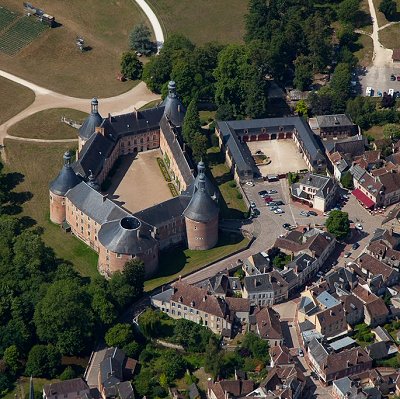
Like us on Facebook
PLACE NAMES


 
|
|
Saint-Fargeau
|

|
|
Saint-Fargeau is a town in Yonne, in the Bourgogne-Franche-Comté region, 29 km east of Châtillon-sur-Loire.
Bordering to the south with the department of Nièvre, close to that of Loiret to the west, its vast territory belongs to the natural region of Puisaye, on the borders of Nivernais, Orléanais and the Burgundy, renowned for its forests, ponds and wet valleys.
Crossed by the course of the Loing, the town being located on its left bank, the locality presents landscapes that are always very green and bucolic, covered for 44% of its area by forests, but also by agricultural land (32%) and meadows (18%).
The village appeared before the year 1000 when the Bishop of Auxerre had a hunting lodge built. Later, Saint-Fargeau was acquired by merchant and banker Jacques Coeur (1450). When he fell into disgrace, it was the judge who ruled on his fate, Antoine de Chabannes, who bought the city and all of Puisaye. The castle was then remodeled, then his son Jean de Chabannes inherited the seigneury. This became a county in 1541 and then passed into the royal family. Saint-Fargeau is then seat of a duchy (1566). Exiled in the city after the Fronde, the Grande Mademoiselle (Anne-Marie d'Orléans, also Duchess of Montpensier and above all first cousin of Louis XIV) had the castle remodeled by the great architect Le Vau (1652).
Rehabilitated in the 20th century, it remains its jewel, the whole of the town having preserved a rich heritage which has justified its being labeled a Small City of Character. With nearly 1,700 inhabitants, Saint-Fargeau also has a varied leisure offer thanks to its body of water on the Loing.
Main sights include:
- Saint-Ferréol church, built in Gothic style in the 14th and 15th centuries. Notable burials: heart of Antoine de Chabannes, whose body was laid to rest in Dammartin-en-Goële; burials of his wife Marguerite de Nanteuil (ca. 1422-1475), and of his son and successor Jean de Chabannes (1462-1503).
- Château de Saint-Fargeau (Saint-Fargeau Castle) mostly built in the 15th and 17th centuries.
- Musée de l'Aventure du Son (Museum of Sound Discovery) displaying more than 1000 gramophones, radios and mechanical musical instruments.
 Feel free to Email me any additions or corrections Feel free to Email me any additions or corrections
LINKS AVAILABLE TO YOUR SITE
| | |





